AMD's Phenom II X4 965 Black Edition
by Anand Lal Shimpi on August 13, 2009 12:00 AM EST- Posted in
- CPUs
And so it ends at 4GHz, again.
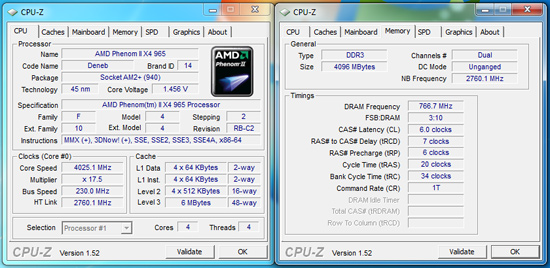
A 625MHz overclock is nothing to sneeze at, but it certainly does not come near those 6GHz~7GHz clock speeds we see on a regular basis with the Phenom II series. Granted, reaching those high clock speeds requires LN2 cooling but there is another important reason. We have discussed it several times and still do not have an acceptable answer from AMD about the inability of the Phenom II to clock much past 4GHz with a 64-bit operating system. Even with LN2 cooling we have not successfully benched past 4.4GHz with a 64-bit OS.
Once again, we tried XP 64-bit, Vista 64-bit, and Windows 7 64-bit and the results are always the same. As we near 4GHz, the voltage requirements increase dramatically and the clocking ability of the processor decreases in much the same manner. This does not occur in a 32-bit operating system, which happens to be the recommendation for any sort of benchmarking activities with the Phenom II.
That said, running this particular processor in the 3.8GHz~4GHz range offers performance that should satisfy just about any desktop user. Moreover, it is easy to do, in fact, much easier than our collection of 955BE samples scattered about the labs.
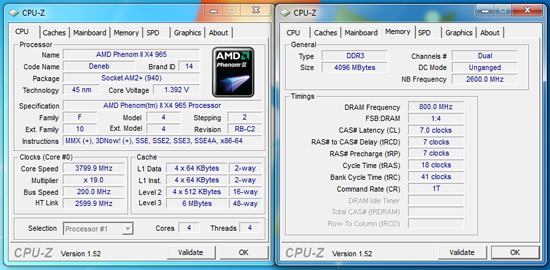
The stock Core VDDC (VCore) is 1.4V as delivered from AMD. At this stock voltage and a slight bump in NB Core voltage to 1.250V, we hit 3.8GHz with a 2.6GHz Northbridge speed on our MSI 790FX-GD70 motherboard. The AMD specific 4GB DDR3-1600 kit from OCZ was set at 1.65V with 7-7-7-18 1T timings. We used the retail air cooler and load temperatures stayed around 58C~62C with Windows 7 Ultimate x64 as the operating system of choice.
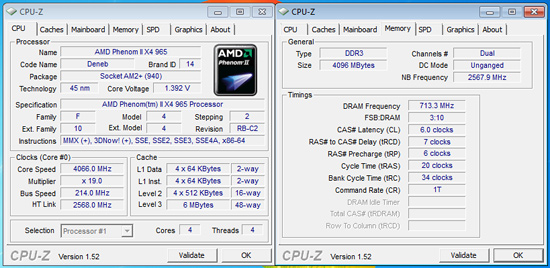
At the same voltages but utilizing Windows 7 Ultimate x86 we end at a final core speed of 4.066GHz (19x214). Northbridge speed is set to 2.567GHz and memory at DDR3-1426 with 6-7-6-20 timings. This is a similar pattern when testing the Phenom II cpus on air-cooling; we typically can clock the processor about 200MHz higher at similar voltages and settings when using a 32-bit OS in place of a 64-bit OS. Our particular sample made it to 4.2GHz on 1.50V with a NB speed of 2.4GHz using our Vigor Monsoon III LT air cooler. We almost hit 4.3GHz at 1.52V with a 2.7GHz NB speed on water cooling before temperatures spiraled out of control.
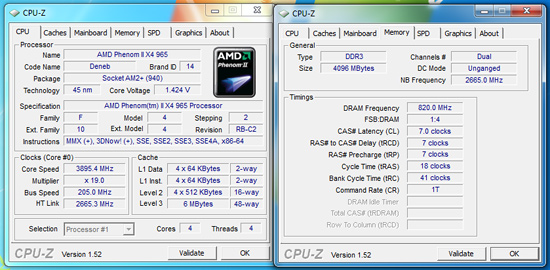
We swapped out our retail air cooler for the Corsair Hydro H50 to hit our top two overclocks. We reached 3.89GHz on 1.45V with the NB speed of 2.66GHz and memory running at DDR3-1640 on 7-7-7-18 timings. When running higher NB speeds, it is a requirement to keep the core as cool as possible to guarantee stability under load conditions. This was our preferred setting as temperatures stayed below 54C under load and the system was very responsive in a variety of applications, especially gaming.
Our best core clock reached 4.025GHz on 1.475V (shown at the top of the page) with a 2.76GHz NB speed and memory operating at DDR3-1532 on 6-7-6-20 timings. Temperatures crept back up to the 58C range under full load conditions.
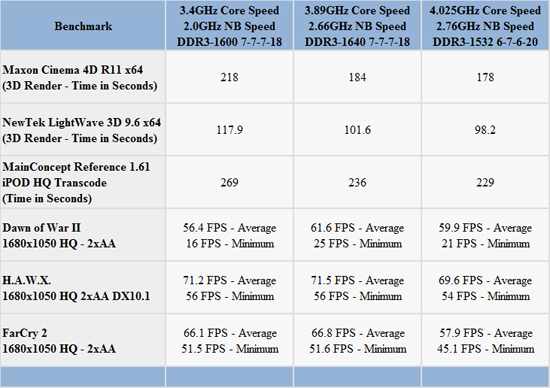
The 4.025GHz setting offered the best results in several video/audio transcoding benchmarks due to pure processor speed, it was actually slower in gaming than the 3.89GHz setting thanks to improved memory bandwidth and internal latencies.
















54 Comments
View All Comments
MODEL3 - Thursday, August 13, 2009 - link
Well if it's true that Core i5 750 is going to launch at 6th of September at 196$,then the only option for AMD is to drop the price around what you suggested! (199$)
Traditionally AMD official pricing translates around 5% lower (in actual street price) than Intel equivalent price
(although in the recent years Intel had various questionable tactics like direct rebates to Retailers & to System Builders without a specific sales target - in the Europe region)
I just hope that AMD is clever to understand, that in no way has to release a higher clocked model (975 3,6GHz, & 985 3,8GHz)
before Intel release in Q1 2010 & in Q3 2010 the higher clocked models of i5 7XX (i5 760 2,8GHz & i5 770 2,93GHz) (if this is indeed the Intel future roadmap at 196$)
Already some sites, that are with Intel side can easily fix the testing method, in order the Core i5 750 to appear more powerful than even a future 975 3,6GHz!
The performance difference between Phenom II architecture & Nehalem architecture can have wide variation depending on the testing method!
So if Intel wants, it can influence some sites to use specific methods to declare a Core i5 750 better than even a future 975 3,6GHz!
What good will do to AMD to release a 975 at a 245$ in Q4 2009?
Of cource AMD can price it at at 219$ (20$ difference with 965) but the whole situation is becoming depressing (they are fighting for +20$ for only a quarter until Q1 2010)
Well, i guess they must make everything, in order to survive!
GeorgeH - Thursday, August 13, 2009 - link
"AMD ought to get rid of the Xn suffix and just use simple model numbers at this point."I understand what you're saying, but I think it's the most straightforward processor naming scheme in a long time. You get the architecture, cores, relative speed, and locked/unlocked instantly. Unless AMD is going to stop selling 2 and 3 core chips and never offer more than 4 cores in the consumer space, I say keep the "Xn".
Intel could really learn from AMD here; from your writeup on ix branding, I fully expect to be needing a decoder ring to figure out what a particular i3/i5/i7 really is.
Drazick - Thursday, August 13, 2009 - link
It seems Intel advantage is more about optimization than much better processor, is this assumption true?Why isn't AMD put efforts into that?
Thanks.
Drazick - Thursday, August 13, 2009 - link
It should be easy to create some test scenarios and measure time.Many High End users use those kind of software.
GourdFreeMan - Thursday, August 13, 2009 - link
The problem with benchmarking such packages is that depending on their target application they will not stress systems in a uniform way. Large matrix computation will likely be bound by memory bandwidth, while numeric computation at machine precision will hinge on FPU/SSE performance, and symbolic calculations will largely be bound by integer and branching performance. There isn't one uniform application that is representative of the needs of all scientists and engineers.XtAzY - Thursday, August 13, 2009 - link
I got my i7 920 for $200 at MicroCenter, much cheaper than $280 online deals! This AMD definately does not worth $245!!Griswold - Thursday, August 13, 2009 - link
And how much did you pay for the mobo and triple channel kit, dumbass?Exar3342 - Thursday, August 13, 2009 - link
LOL, your the dumbass. :)6GB triple Channel - (Newegg) $85.00
8GB dual channel (newegg) $95.00
X58 MB - $165-175
AM3 MB $85-120
So you are talking a difference or $40-60, which if you can get the i7 at Microcenter (I was there last week and they had a ton) erases any price differences.
Griswold - Saturday, August 15, 2009 - link
Oh, lets look at the other article anand just put up, dumbass. Your shit doesnt quite add up...rhog - Thursday, August 13, 2009 - link
Since when can you get a "good" x58 for lest than 200?I assume the 200 Bucks is a Mail in rebate price as well. I own 2 i7 920 great processor but hardly any faster at 3.6ghz than a 3.8ghz AMD 955 (at most 20%) which is in line with the "real" 100-125 Buck difference in cost. You can get a really nice Video card upgrade for that money. Don't forget the i7 920 never runs at 2.6ghz but always overclocks itself making it hard to do a good clock for clock comparison. The AMD 965 is better than Core2 and I doubt that the Core i5 will be faster than a Core i7 so they should compete well. Oh, and the Core i5 will overclock itself as well I here as much a 3 mults